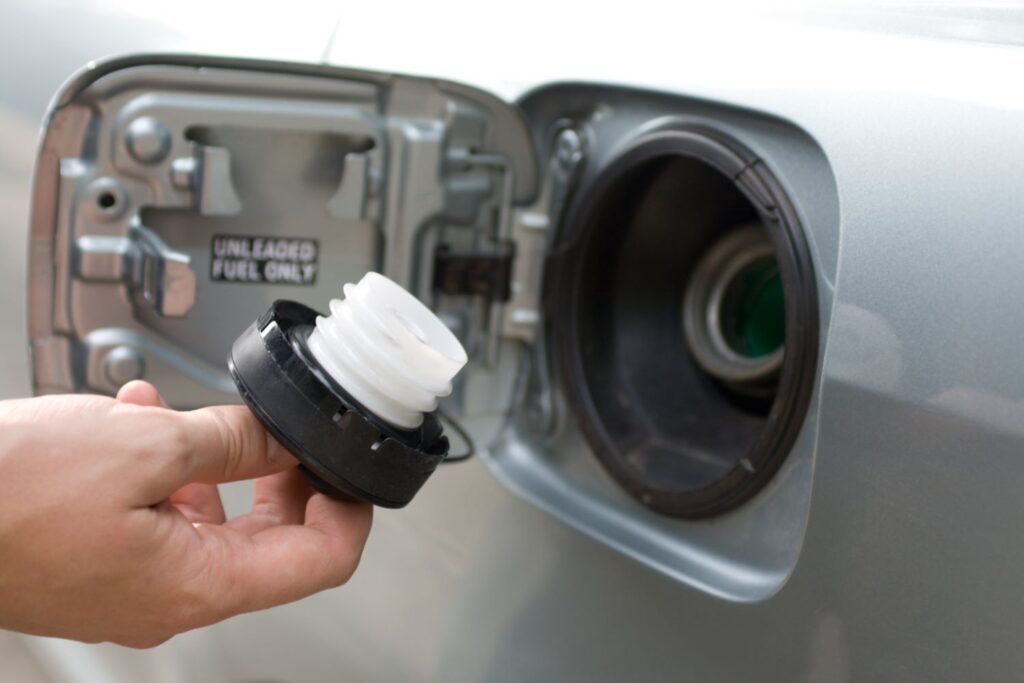What Is a Gas Cap?
The gas cap is the physical cover for the fuel filler that leads to your vehicle’s gas tank. It’s also called the fuel filler cap. While automobile manufacturers have introduced capless fuel fillers that dispense with the need for a gas cap, the overwhelming majority of older vehicles on the road still use the old-fashioned cover. Over time, this part can fail. Learning about the symptoms of a failing gas cap can help you get a head start on maintenance and repair.

Bad Gas Cap Symptoms
The gas cap fulfills a crucial role and can cause problems for your vehicle if it fails. Here’s a list of the most common faulty gas cap symptoms:
Gas Cap Cannot Be Tightened
The gas cap reduces the chances of a fuel leak by sealing the filler neck. However, fuel vapor can seep past the cap if it loses its ability to maintain the seal. The ensuing leak will cause a drop in the air pressure within the EVAP system. When the powertrain control module (PCM) detects a leak, it will log the appropriate trouble code and illuminate the check engine light.
Bad gas caps are only one of the possible issues that can trigger the check engine light. Check the diagnostic trouble codes stored in your vehicle’s computer to see if they’re related to a bad gas cap.
Fuel Odor
Gasoline possesses a distinct smell of sulfur or rotten eggs. If you repeatedly catch whiffs of fuel in the air despite closing the fuel filler cap, the cap might have worn out.
The gas cap doesn’t only keep contaminants out of the gas tank. It also prevents vaporized fuel from escaping the fuel system. Along with the fuel filler neck seal, the cap ensures that the evaporative emission control (EVAP) system can collect the vapor later.
However, the gas cap seal can break down over time. If the seal fails, fuel vapor can seep past the fuel filler cap and escape outside the gas tank.
Check Engine Light Illuminates
When the check engine light switches on, you know something’s gone wrong with the engine or the other systems that support its operation.
The gas cap seals the filler neck, minimizing the chance of a fuel leak. However, if the cap loses its ability to maintain the seal, fuel vapor can seep past it. The ensuing leak will cause a drop in the air pressure within the EVAP system. When the powertrain control module (PCM) detects the pressure loss, it will log the appropriate trouble code and activate the check engine light.
Bad gas caps are only one of the possible issues that can trigger the check engine light. Check the diagnostic trouble codes stored in your vehicle’s computer and see if they’re related to a bad gas cap.

More About the Fuel Cap
Most gas caps use sturdy plastic and metal in their construction. Their seals use elastic material like rubber, which can expand and contract to better maintain a seal.
Gas caps have ridges on their outside that thread into the fuel tank’s filler neck to lock them in place. Older designs use continuous threading. Newer caps have lugs that work like threads. In luxury vehicles, gas caps feature an elaborate system of springs and valves that lock them in place.
In addition to the standard gas cap, you can find locking gas caps that offer greater security. The locking type reduces the risk of someone tampering with the fuel tank.

How Often Should the Gas Cap Be Replaced?
The fuel filler cap is often used, so it has a relatively short service life and can require regular replacement. You’ll usually need a replacement cap at least once before your vehicle reaches 100,000 miles.
Test the gas cap when you bring your vehicle in for its regular maintenance session. You might discover that this part has worn out prematurely and needs to be replaced.
How Much Does a Replacement Gas Cap Cost?
A replacement gas cap can go for as low as $10 and as high as $130, depending on factors like brand and your vehicle’s year, make, and model.
Where to Get New Gas Caps for Your Vehicle
If you’re experiencing any of the symptoms listed above, then it might be time to replace your gas cap. Don’t put it off to keep your fuel secure. For a gas cap replacement that’s sure to fit your ride, shop online at CarParts.com.
With only a few clicks, you can find the right part for your ride on our website. Fill out our vehicle selector to view the gas caps that are compatible with your daily driver. Our products have accurate and detailed fitment information, but if you have questions, you can contact our customer service team via our toll-free hotlines for further assistance.
Here at CarParts.com, you’ll never go over budget while shopping for your automotive needs. Our gas caps are available at competitive prices. Shop today, and get your order in as fast as two business days.
Check out our catalog today!
Any information provided on this Website is for informational purposes only and is not intended to replace consultation with a professional mechanic. The accuracy and timeliness of the information may change from the time of publication.





























